Chinguetti
City of Libraries | |
|---|---|
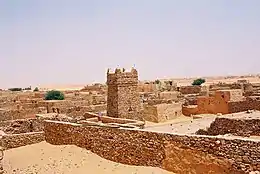 Old town, Chinguetti | |
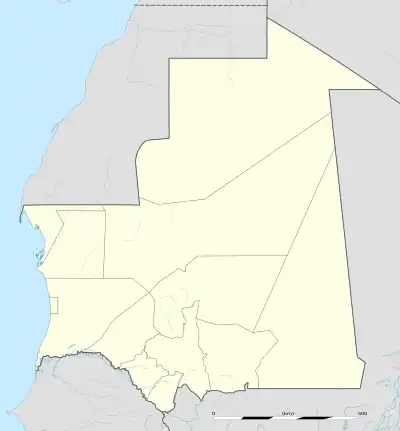 Chinguetti Location in Mauritania | |
| Coordinates: 20°27′N 12°21′W / 20.450°N 12.350°W | |
| Country | |
| Region | Adrar Region |
| Population (2000)[1] | |
| • Total | 4,711 |
| Official name | Ancient Ksour of Ouadane, Chinguetti, Tichitt and Oualata |
| Type | Cultural |
| Criteria | iii, iv, v |
| Designated | 1996 (20th session) |
| Reference no. | 750 |
| Region | Arab States |
Chinguetti (/ʃiŋˈɡɛti/) (Arabic: شنقيط, romanized: Šinqīṭ) is a ksar and a medieval trading center in northern Mauritania, located on the Adrar Plateau east of Atar.
Founded in the 13th century as the center of several trans-Saharan trade routes, this small city continues to attract a handful of visitors who admire its spare architecture, scenery, and ancient libraries. The city is seriously threatened by the encroaching desert; high sand dunes mark the western boundary and several houses have been abandoned to the sand.
The town is split in two by a wadi. On one side, there is the old sector, and on the other the new one. The indigenous Saharan architecture of older sectors of the city features houses constructed of reddish dry-stone and mud-brick techniques, with flat roofs timbered from palms. Many of the older houses feature hand-hewn doors cut from massive ancient acacia trees, which have long disappeared from the surrounding area. Many homes include courtyards or patios that crowd along narrow streets leading to the central mosque.
History
Occupied for thousands of years, the Chinguetti region was once a broad savannah; rock paintings at Agrour Amogjar, in the nearby Amogjar Pass, feature images of giraffes, cows, and people in a green landscape. It is quite different from the sand dunes of the surrounding desert, which make up most of the region today.[2]
Founding
The city was founded in AD 777. The name Chinguetti means "spring of horses" in the Azayr language, an extinct dialect of Soninke that was heavily mixed with Berber. The area, at that time far more green than today, was home to agricultural peoples ancestral to several sub-Saharan ethnic groups, including the Soninke.[3] : 15, 71
Center of Trade
By the 11th century, Chinguetti had become a trading center for a confederation of Berber tribes, known as the Sanhaja. They eventually melded with the Almoravids, represented by Abdallah ibn Yasin, who would eventually control an empire stretching from present-day Senegal to al-Andalus in modern-day Spain. The city's stark, unadorned architecture reflects the strict religious beliefs of the Almoravids, who spread the Malikite rite of Sunni Islam throughout the Western Maghreb.
After two centuries of decline, the city was effectively re-founded in the 13th century as a fortified trading-center for nomadic trans-Saharan caravans, and as a means of connecting the Mediterranean with Sub-Saharan Africa. Although the walls of the original fortification disappeared centuries ago, many of the buildings in the old section of the city date from this period.
World Heritage Site
In 1996, UNESCO designated Chinguetti, along with the cities of Ouadane, Tichitt and Oualata, also in the dunes area, as a World Heritage Site.[4] Notable buildings in the town include The Friday Mosque of Chinguetti, an ancient structure of dry-stone construction, featuring a square minaret capped with five ostrich egg finials; the former French Foreign Legion fortress; and a tall watertower. The old quarter has five important manuscript libraries of scientific and Qur'anic texts, with many dating from the later Middle Ages. In recent years, the Mauritanian government, the U.S. Peace Corps, and various NGOs have attempted to position the city as a center for adventurous tourists. Visitors may "ski" down its sand dunes, visit the libraries, and appreciate the stark beauty of the Sahara.
The Friday Mosque is widely considered by Mauritanians to be the national symbol of the country.[2] The recently discovered offshore oilfield was named Chinguetti in its honor.
Religious importance
For centuries, the city was a principal gathering place for pilgrims of the Maghreb to gather, on their way to Mecca. It became known as a holy city in its own right, especially for pilgrims unable to make the long journey to the Arab Peninsula. It also became a center of Islamic religious and scientific scholarship in West Africa.[5] In addition to religious training, the schools of Chinguetti taught students rhetoric, law, astronomy, mathematics, and medicine. For many centuries, all of Mauritania was commonly known in the Arab world as Bilad Shinqit, "the land of Chinguetti." It is sometimes said to be the seventh-most holy city of Islam,[6] but there is no formal recognition of this claim outside of West Africa. The city remains one of the world's most important historical sites both in terms of the history of Islam and the history of West Africa.
Although largely abandoned to the desert, the city features a series of medieval manuscript libraries without peer in West Africa. The area around the Rue des Savants (or “street of intelligent ones”) was once famous as a gathering place for scholars, and as a place to debate the finer points of Islamic law. Today, the quiet city still offers the urban and religious architecture of the Moorish empire as it existed in the Middle Ages.[7]
Climate
In 2021 Chinguetti was featured in a BBC documentary Life at 50 degrees C, which looked at ordinary people living in increasingly inhospitable areas.[8]
| Climate data for Chinguetti | |||||||||||||
|---|---|---|---|---|---|---|---|---|---|---|---|---|---|
| Month | Jan | Feb | Mar | Apr | May | Jun | Jul | Aug | Sep | Oct | Nov | Dec | Year |
| Mean daily maximum °C (°F) | 26.0 (78.8) |
28.6 (83.5) |
30.9 (87.6) |
33.5 (92.3) |
37.1 (98.8) |
40.5 (104.9) |
41.3 (106.3) |
40.4 (104.7) |
39.0 (102.2) |
36.0 (96.8) |
31.1 (88.0) |
26.2 (79.2) |
34.2 (93.6) |
| Mean daily minimum °C (°F) | 11.5 (52.7) |
13.0 (55.4) |
15.4 (59.7) |
17.7 (63.9) |
21.0 (69.8) |
24.7 (76.5) |
25.7 (78.3) |
25.5 (77.9) |
24.5 (76.1) |
21.3 (70.3) |
16.7 (62.1) |
12.2 (54.0) |
19.1 (66.4) |
| Average precipitation mm (inches) | 2 (0.1) |
2 (0.1) |
2 (0.1) |
0 (0) |
1 (0.0) |
2 (0.1) |
6 (0.2) |
18 (0.7) |
18 (0.7) |
7 (0.3) |
4 (0.2) |
2 (0.1) |
64 (2.5) |
| Source: Climate-data.org | |||||||||||||
Gallery
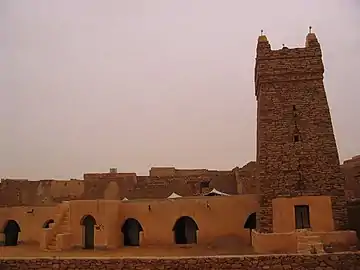 The Great "Friday Mosque"
The Great "Friday Mosque" Inside a Qur'anic Library
Inside a Qur'anic Library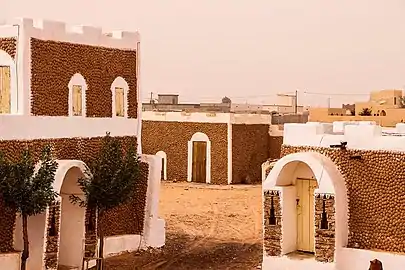 New town architecture of Chinguetti
New town architecture of Chinguetti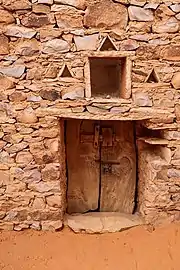 Massive hand hewn door cut from acacia trees
Massive hand hewn door cut from acacia trees
Notable residents
- Ahmad ibn al-Amin al-Shinqiti (1863–1913), who was born and lived here, is one of Mauritania's most famous writers.
- Muhammad al-Amin al-Shinqiti (1887–1973), an Islamic scholar.
See also
- Chinguetti oil field, Mauritania's first offshore oil field
- Greater Mauritania, (بلاد شنقيط; Bilād Šinqīṭ; Bilad Chinguetti)
- The Chinguetti meteorite is a find reputed to come from a large unconfirmed “iron mountain”, located in the nearby of the town.
Notes
- ↑ Statistiques Démographiques : Résultats du RGPH 2000 des Wilayas, La Marie de la Commune de Ain Ehel Taya, archived from the original on 9 March 2009, retrieved 7 August 2011.
- 1 2 Maglaty, Jeanne (March 2009). "Endangered Site: Chinguetti, Mauritania". Smithsonian Magazine. Smithsonian Institute. Retrieved 1 January 2024.
- ↑ Webb, James (1995). Desert frontier : ecological and economic change along the Western Sahel, 1600-1850. Madison: University of Wisconsin Press. p. 29. ISBN 0299143309. Retrieved 25 December 2023.
- ↑ Ancient Ksour of Ouadane, Chinguetti, Tichitt and Oualata, UNESCO World Heritage Centre, retrieved 2017-08-21
- ↑ "The Importance of Mauritanian Scholars in Global Islam". Middle East Report Online. 2021-04-13. Archived from the original on 2021-04-13. Retrieved 2021-10-31.
- ↑ "Chinguetti in the Mauritanian Sahara is the seventh holiest city of Islam". Researche Gate. Archived from the original on 2021-11-13. Retrieved 13 November 2021.
- ↑ "Inside the abandoned city of ancient libraries". BBC. 4 March 2020.
- ↑ "Life at 50 Degrees". BBC. 2021.
External links
- Map showing Chinguetti: Fond Typographique 1:200,000", République Islamique de Mauritanie: Chinguetti Sheet NF-28-VI
- UNESCO on Chinguetti
- Mauritania Today – Chinguetti
- Chinguetti's manuscripts, Saudi Aramco World
- U.S. Department of State Reports – Mauritania
- Palin's Travels – Chinguetti
- Desert libraries
- Shinqit Forum